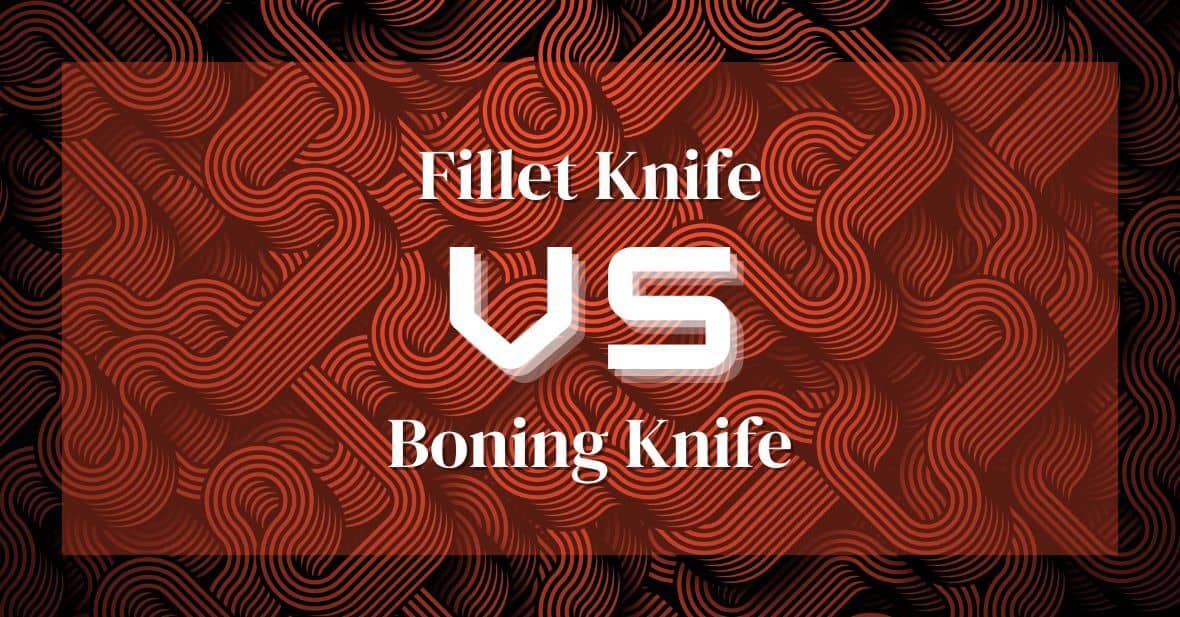Fillet Knife Vs Boning Knife: Which Blade Reigns Supreme?
Do you ever find yourself in the kitchen, trying to decide between a fillet knife and a boning knife?
You’re not alone – it can be difficult to tell the difference. But don’t worry!
We’ve got your back. Read on to learn all about the differences between these two types of knives, so you can make an informed decision and be the master of your cutting board.
After all, knowledge is power!
Blade Length and Shape
When it comes to blade length and shape, you’ll find that there are distinct differences between these two types of knives.
Fillet knives tend to have a longer blade than boning knives, which makes them better suited for filleting fish or poultry. They also have a much thinner and more flexible blade compared to the boning knife, allowing for easy maneuverability around tight corners and curved edges. Plus, they often come with a full tang design – meaning that the metal runs through the entire handle – which adds further strength and stability while using them.
On the other hand, boning knives typically have shorter blades with minimal flex due to their stiffer construction and thicker material; essential for separating meat from connective tissue. To top it off, most boning knives feature a partial tang design where only part of the metal runs into the handle providing you with an extra measure of control when working on tougher cuts of meat.
Flexibility
You’ll find that a fillet knife is much more flexible than a boning knife, making it the perfect tool for any culinary conundrum you may encounter.
With its long, thin blade and ergonomic grip, a fillet knife allows you to get into those hard-to-reach places with ease. The curved design of the blade also gives it incredible grinding ability that can’t be matched by a boning knife – talk about an edge!
Plus, because of its flexibility, it’s great for precision slicing and dicing. Whether you’re dealing with delicate fish filets or thick cuts of beef, the fillet knife has got your back.
Handle Design
The ergonomic handle of the fillet knife provides you with a comfortable grip, allowing you to maneuver it effortlessly for precise cutting. Its curved design reduces hand fatigue and offers superior gripping capabilities compared to other knives.
With its special features, such as a textured handle that ensures non-slip performance, an ergonomic shape that fits perfectly in your hands, and high-quality materials that guarantee durability and grip comfort, you can be sure this is the perfect tool for any job!
The combination of these features makes for an enjoyable experience in the kitchen – no matter how big or small the job.
Uses for a Fillet Knife
A fillet knife is the perfect tool for any job that requires precision and finesse – from delicate slicing to intricate carving. Its sharpness, edge retention, and ease of blade maintenance make it a great choice for tasks like filleting fish or cutting thin slices of meat. With its narrow blade and pointed tip, you can easily maneuver around bones and joints with ease.
The versatility of a fillet knife makes it an essential tool in any kitchen. Whether you’re preparing dinner for your family or catering an event, this knife will help you get the job done quickly and efficiently. Plus, its slim design allows you to store it away without taking up too much space! | Task | Benefits | Drawbacks | | — | — | — | | Sharpness | Easily cuts through tough materials like bone or cartilage | Can be too sharp if not handled properly| | Blade Maintenance | Easy to sharpen and maintain edge retention over time | Requires regular maintenance to keep sharpness level high| | Edge Retention | Maintains sharpness even after multiple uses over time | Needs frequent honing to maintain edge retention levels|
Uses for a Boning Knife
With its narrow blade and curved shape, a boning knife is perfect for tackling tough tasks like removing meat from the bone or trimming fat. It’s an essential tool for any kitchen enthusiast who desires to create show-stopping dishes. The key to using a boning knife successfully is mastering the proper cutting techniques.
This involves holding the handle in one hand and applying pressure with your other hand as you cut along the bone of your chosen protein. With practice, you’ll be able to skillfully remove meat in no time!
When it comes to sharpening tips, honing rods are ideal for keeping boning knives in tip-top condition. If you regularly use a honing rod before each use, it’ll help keep your blades razor-sharp while also helping them last longer.
You should also never put a boning knife in the dishwasher as this can damage its edge. Instead, always wash it by hand with warm soapy water and dry it immediately after use. With these simple tips in mind, you’ll be ready to tackle any cooking task with ease!
Conclusion
You might be wondering which knife is right for you. It all comes down to understanding the difference between a fillet knife and a boning knife.
The two knives are designed differently, with different lengths of blades and flexibility, as well as different handle designs.
Think of them like two dancers: one spinning gracefully around the other in perfect synchronization. Each has its own unique uses that make it ideal for particular tasks.
Knowing when to use each will help you take your culinary skills to the next level!
Frequently Asked Questions
What Is The Best Type Of Metal For A Fillet Knife Or Boning Knife?
when it comes to fillet and boning knives, the two top contenders are stainless steel and ceramic blades. Stainless steel is strong, durable, and easy to sharpen, making it a great option for those who want a knife that will last them a while.
On the other hand, ceramic blades are incredibly sharp and can retain an edge much longer than stainless steel. Plus, they’re lightweight and won’t rust or tarnish over time!
How Often Should A Fillet Knife Or Boning Knife Be Sharpened?
Sharpening a knife isn’t just about convenience – it’s also about technique. Whether you’re slicing delicate fillets or removing bones with precision, maintaining the right sharpening angles and cutting technique is essential for top-notch results.
How Should A Fillet Knife Or Boning Knife Be Stored?
Storing your knives safely and properly is essential for keeping them in the best shape possible. Using cases or covers to protect blades from dust and other debris is a great way to ensure their longevity. Cleaning them regularly also helps keep your knives in good condition. However, it’s important to make sure they’re completely dry before storing them away.
Are Fillet Knives Or Boning Knives Better For Cutting Through Bone?
If you’re trying to decide between a fillet knife or a boning knife for cutting through bone, it’s important to consider the flexibility of the knife and the size of its blade.
While fillet knives are known for their sharpness and thin blades, they can be too flexible for tough bones. On the other hand, boning knives have stiffer blades that are designed specifically for cutting through bone while still maintaining precision.
Are Fillet Knives Or Boning Knives Better For Making Precise Cuts?
When it comes to making precise cuts, knife selection is key. Whether you’re looking for a razor-sharp cut or something more intricate, the type of knife you choose will determine your success.
For those seeking precision in their cutting technique, a boning knife is usually the best choice. Its narrow blade allows for detailed slicing of meats and vegetables with ease.
On the other hand, fillet knives have wider, flexible blades that are ideal for working with fish and other delicate items – but may not be as suitable when precision is needed.
Additional Resources
The Art of the Slice: A Dive into Japanese Knife Types
Western Style Knives 101 | A Comprehensive Introduction to the Basics
19 Types of Kitchen Knives & Their Uses
9 Kitchen Knife Care Tips for Maintaining Your Edge
Forging Culinary Excellence: The Best Steel For Kitchen Knives

